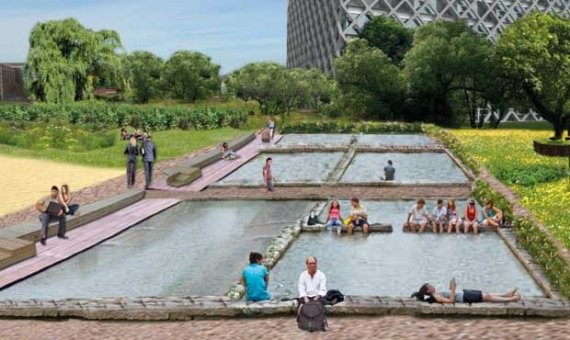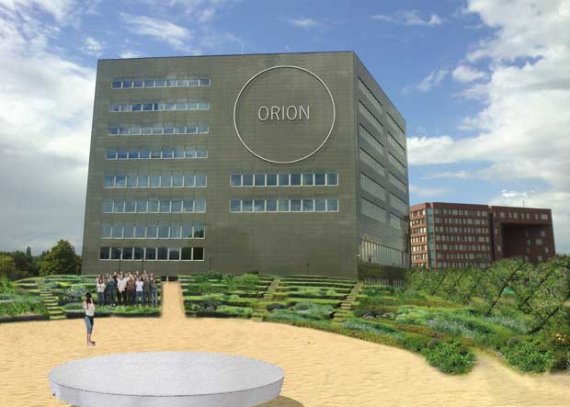Is this De Born? All that greenery, the trees and pools. Billowing grain along the path to Orion, pollarded willows near Atlas. Who said the campus was dull? If it is up to the creative souls behind the Edible Academic Garden (the Dutch acronym is EAT), the campus will be as green and sustainable as the pictures suggest. The EAT project presented the results of 18 months’ work in the Forum last week.
Garden might not be the right word, really. The project involves a total restructuring of the eastern side of the campus. According to the EAT initiators, this ‘hotspot’ at De Born should become Wageningen UR’s calling card. Wageningen as ‘a world leader in the field of innovative academic gardens’. Complete with an amphitheatre, an orchard, several splashpools, a herb garden, and with willow-lined paths and ditches to keep the seeping groundwater under control. Plus an ingenious hydrological system driven by a battery of home trainers.
The chances of this plan being adopted in its entirety are minimal
Elike Wijnheimer
About 60 people (most of them students) have worked on the project for 18 months in brainstorming sessions, workshops and design meetings to come up with a plan that meets with broad support. But the chances of the design really getting off the ground are small, says Elike Wijnheimer, who works at Facilities and Services and is coordinator for outdoor space on the campus. ‘The chances of this plan being adopted in its entirety are minimal.’ That does not mean she does not think it a lovely idea. But it is not very realistic, she feels. No agreement has been reached, not even about the location of the garden. ‘Officially the plan has no status at all.’
‘I have three questions,’ responds her colleague Joris Fortuin, head of Education Facilities. ‘One: what would it cost to set up? Two: what would maintenance cost? And three: Who is going to organize all this? These are exactly the questions the executive board ask if I come along with a plan like this.’

Fortuin thinks the plan is overambitious and therefore probably too expensive. He advises the group to split the plan up in bits. But that is difficult, according to Fiona Morris, alumna, landscape architect and leader of the design team. ‘It is an integral design, which you cannot just cut bits out of.’According to Morris, the ball is now in the court of the organization. ‘This is a present from us to Wageningen UR. Up to now it was all volunteer work. Without support we cannot develop this further. We cannot take that step. It is not realistic to expect that of us.’According to Wijnheimer, things are not that far yet. ‘For two months now the Campus Development steering committee has been working on a plan for the whole campus. That area is just one part of it.’ But she thinks there are some usable ideas in the plan. ‘An amphitheatre, for example, would be nice at that spot. We shall certainly come back to EAT.’

